

Olive tree, both potted and planted in the ground, certainly is a kind of tree that garners much attention these days.
Olive tree key facts
Name – Olea europea or europaea
Family – Oleaceae
Type – fruit tree
Height – 10 to 13 feet (3 to 4 m)
Exposure – full sun
Soil – well-drained, chalky, dry
Foliage – evergreen – Harvest – September to December
Caring, pruning and watering all take a part in letting olive trees grow well.
Planting an olive tree, both in the ground and in pots, requires great care and attention. A well-planted tree will have stronger growth.
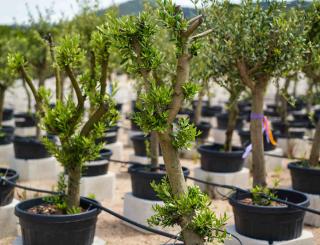
Also try to shelter olive trees from strong winds, especially if you aren’t in Mediterranean climates.
As for soil, ensure that it is very well drained.
Mix sand into your soil and cover the bottom of the hole with small rocks to ensure that water never sits near the roots.
Growing olive trees in pots is perfectly possible as they adapt well.
Pruning olive trees is recommended yearly at the end of the winter / beginning of spring.
Olive trees prefer light pruning to severe pruning. But if you must drastically reduce branches, do so in fall if freezing is rare in your area, and in spring elsewhere.
Moreover, never prune your olive tree in winter, before or during a freezing spell, since this could kill your trees. If you prune your trees in fall or autumn, they will grow new buds that will be very vulnerable to frost and freezing. Olive trees pruned in fall or winter might freeze.
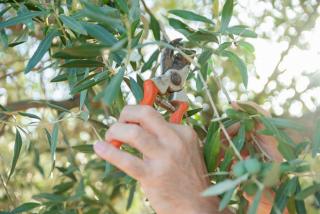 Remove branches that have grown from the foot of the tree or along the trunk.
Remove branches that have grown from the foot of the tree or along the trunk.A good tip to remember which branches to cut is ICU for Inwards – Crossing – Upwards. As in, “I see you, ICU!”
After pruning, if you’re suspicious that fungus may have infected leaves, burn the leaves.
Add olive tree fertilizer to get a magnificent olive tree with abundant harvests.
Olive trees are biennial fruiting trees, meaning that the harvest is bountiful one year and meager the next. Pruning yearly helps even out production.
Among the hardy olive cultivars, here are the most common: ‘aglandau’, ‘amellau’, ‘frangivento’ and ‘olivère’.
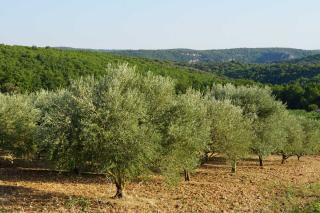
Finally, if you wish to only plant one tree, the most common self-pollinating varieties are ‘aglandau’, ‘amygdalolia’, ‘frangivento’, ‘cayon’, ‘grossanne’, or ‘poumal rougette of Ardèche’.
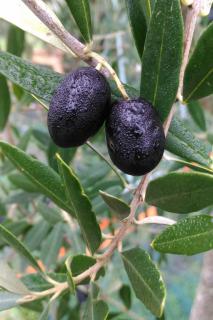
A Spanish olive tree cultivar that has spread throughout the world is the famous and hardy ‘Arbequina’. Arbequina olive trees were originally bred and grown in Catalonia, in Spain. Other Spanish olive tree varieties inclure ‘Sevillano’
Tunisian cultivars are also interesting, like the ‘Chemlali’.
Newer South American olive varieties include the ‘Arauco’ (Argentina), ‘Criolla’ (Peru) and ‘Azapa’ (Chile).
Israel also is home to some olive varieties, like the ‘Barnea’.
For growing olive trees in pots, choose the ‘Amygdalolia’ variety, which naturally grows to smaller sizes.
The olive tree resists diseases very well, and they rarely are fatal. Nonetheless, some parasites are common and it is worth treating them so as to not weaken the olive tree.
In recent years, a bacterial disease called Olive Quick Decline Syndrome has spread to Europe. Tree leaves dry out and the tree dies within a few years. The bacteria that causes this is Xylella fastidiosa.
<!– silent
–>
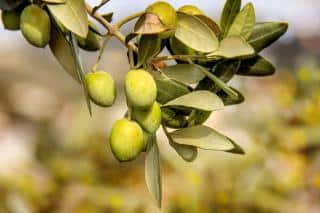
This tree has a lifespan that extends over a thousand years. It is typical of Mediterranean regions, but it can be found already in more temperate climates. For example, growers are already planting it along the Atlantic coast.
Some succeed in growing it in the North, as long as it is well-endowed with sunlight and sheltered from excessive moisture. Olive trees will survive temperatures colder than 23°F (-5°C) if properly hardened. Cold is even necessary for olive production.
Its edible fruits are olives. They’re most often black or in shades of green. The closer the growing conditions are to their native environment, the more abundant the harvest.
Olives can be eaten raw, though they are better when they are prepared. Take note! Raw olives very bitter and the fact that they look like sweet grapes is deceiving! They are often pressed to produce olive oil which is famous for all the health benefits of olives on health!
In rather temperate climates and in cases of strong frost spells, cover your olive tree with horticultural fleece to protect it from the cold!
Read also:
©ElenaElisseeva, ©Jenoche/AdobeStock, ©Renata
We have 2 very mature olive trees in our yard. We have growth that comes out of the base of the trees and we must cut this new growth off or it will continue to grow. Is there someway to control this growth without harming the trees.
I found the piles of green leaves under all 32 trees this morning. There was no sign of leaf drop as of yesterday afternoon. The leaves are still falling, slowly unless the branches are disturbed and then they fall heavily.
The high was 90 yesterday the low was 51.
The fruit is not dropping and look healthy.
Every year I spray twice a season, later in the summer for spider mite infestation which affects many of the plants in the park. I use a dish soap, mineral oil and water mixture. Up unitl this year the olives didn’t seem to be affected by spider mites but I noticed webbing on many of the olves this year so I included them in the application this year. I sprayed last Wednesday.
A few years ago many of the olives were weeping. But I have tried to correct what may have been the cause of the weeping and since then and other than that one year there hadn’t been any more signs of weeping. The leaves that are dropping aren’t yellow they are green, some peacock but minimal.
Though such loss of leaves may seem troubling, I think it’s a rather good sign. It means the cause is environmental, and not a disease. The trees are dropping their leaves as a response to a stress, it’ll make it easier for them to bounce back. That said, what causes this?
Temperature was low but not exceptionally so, well within normal coping range. Past weeping also probably isn’t a cause.
It may be that a certain water stress existed and the tipping point was reached. But it wouldn’t be so sudden nor would it equally affect all trees.
I would suspect the spraying. When a mixture incommodates a small plant, leaves fall within hours. A week for ill effects to show on a tree isn’t unexpected. If the trees were under any sort of stress, spraying has a disproportionate effect on them since they react more strongly.
At this point, I would not prune anything away at all. The trees are shedding leaves and will grow new ones. Leaf growth will be delayed because it’s the fruiting season, which diverts energy. Fruit formation accounts for over 30% of olive water and nutrient expenditures. To help the tree, you might want to thin some fruits, such as removing one out of three or such. However, if not done, the tree should still recover, but over a slightly longer period.
To confirm if the spray was responsible or not, ask a neighbor who has olive trees of the same variety if you can spray a single tree. Perhaps the cause may be replicated (at the cost of that tree’s leaves).
In any case, I would also check with neighbors and with the local Department of Agriculture office or State University extension office. Have they also experienced this? Bring a few leaves and freshly cut twigs in case they feel an analysis is needed. Note the exact dish soap and mineral oil that were used.
The olive trees within the 38 tree groves in Northern California have all of a sudden had a major leaf drop. It happened overnight. If the branches are slightly disturbed it causes more leaf drop. There are a pile of leaves under each tree. Any idea of the cause of this?
Hi Lynn, good question. Since it affected many orchards at once, it’s possibly temperature-related. When did this happen? What temperatures were recorded? There was a low overnight last week with temps dropping to 55°F / 13°C and colder, which is a bit out of season.
Are fruits dropping, too? Any signs of disease? Yellowing beforehand?
Many olive orchards in CA are super-high density. Are those and traditional orchards hit in the same manner?